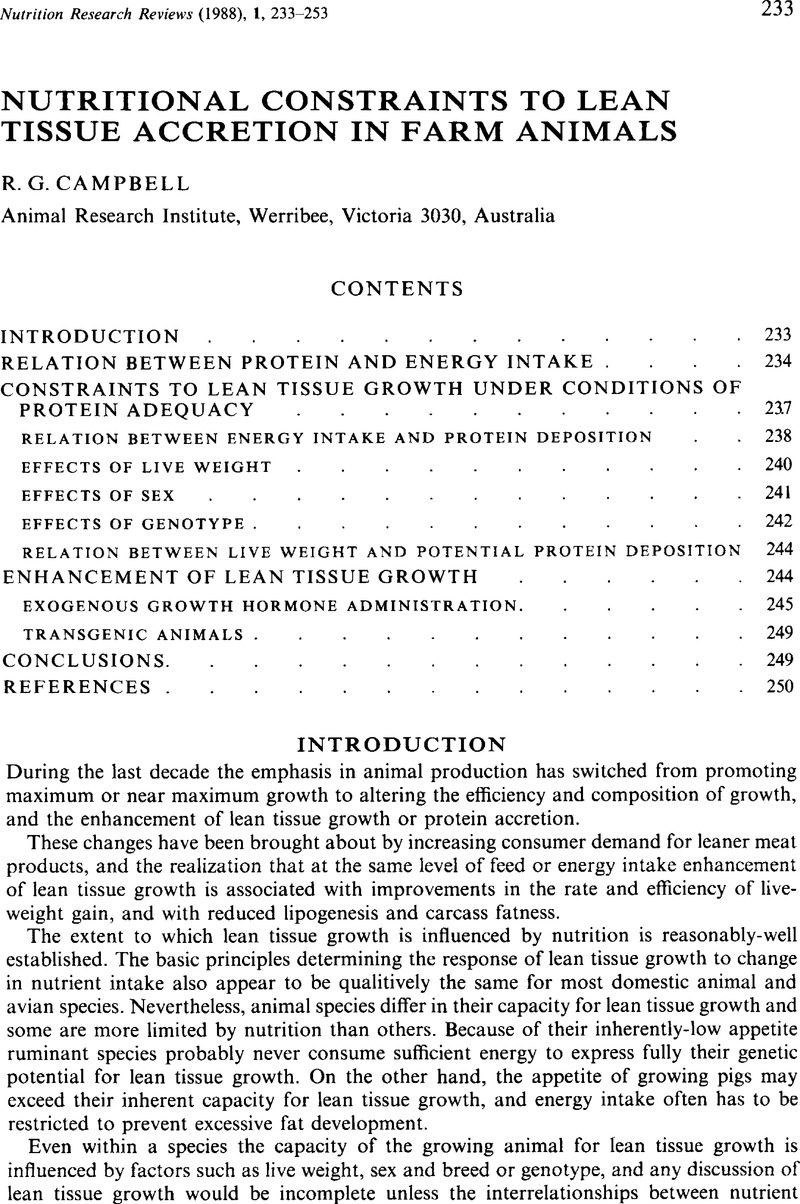Crossref Citations
This article has been cited by the following publications. This list is generated based on data provided by Crossref.
Rao, D. S.
and
McCracken, K. J.
1990.
Protein requirements of boars of high genetic potential for lean growth.
Animal Science,
Vol. 51,
Issue. 1,
p.
179.
BUTTERY, P.J.
1990.
Recent Advances in Animal Nutrition.
p.
201.
Buttery, Peter J.
and
Dawson, Janet M.
1990.
Growth promotion in farm animals.
Proceedings of the Nutrition Society,
Vol. 49,
Issue. 3,
p.
459.
Dawson, J.M.
and
Buttery, P.J.
1991.
Animal Biotechnology and the Quality of Meat Production.
p.
49.
Young, V. R.
1991.
Nutrient interactions with reference to amino acid and protein metabolism in non-ruminants; particular emphasis on protein-energy relations in man.
Zeitschrift für Ernährungswissenschaft,
Vol. 30,
Issue. 4,
p.
239.
Nossaman, David A.
Schinckel, Allan P.
Miller, Lindy F.
and
Mills, Scott E.
1991.
Interaction of Somatotropin and Genotype on the Requirement for Energy in Two Lines of Finishing Pigs.
The Journal of Nutrition,
Vol. 121,
Issue. 2,
p.
223.
Bass, J.J.
Hodgkinson, S.C.
Breier, B.H.
Carter, W.D.
and
Gluckman, P.D.
1992.
Effects of bovine somatotrophin on insulin-like growth factor-I, insulin, growth and carcass composition of lambs.
Livestock Production Science,
Vol. 31,
Issue. 3-4,
p.
321.
BEERMANN, D.H.
and
BOYD, R.D.
1992.
The Control of Fat and Lean Deposition.
p.
249.
Kyriazakis, I.
and
Emmans, G. C.
1992.
The effects of varying protein and energy intakes on the growth and body composition of pigs.
British Journal of Nutrition,
Vol. 68,
Issue. 3,
p.
603.
BELL, A.W.
1992.
The Control of Fat and Lean Deposition.
p.
111.
TAMMINGA, S.
and
VERSTEGEN, M.W.A.
1992.
Recent Advances in Animal Nutrition.
p.
113.
Croom, Warren J.
Bird, Anthony R.
Black, Betty L.
and
McBride, Brian W.
1993.
Manipulation of Gastrointestinal Nutrient Delivery in Livestock.
Journal of Dairy Science,
Vol. 76,
Issue. 7,
p.
2112.
Walker, B.
and
Young, B.A.
1993.
Prediction of protein accretion, support costs and lipid accretion in the growing female pig and dry sow.
Agricultural Systems,
Vol. 42,
Issue. 4,
p.
343.
Krick, Beatrice J
Boyd, RDean
Roneker, Karl R
Beermann, Donald H
Bauman, Dale E
Ross, Deborah A
and
Meisinger, David J
1993.
Porcine Somatotropin Affects the Dietary Lysine Requirement and Net Lysine Utilization for Growing Pigs.
The Journal of Nutrition,
Vol. 123,
Issue. 11,
p.
1913.
Beermann, D.H.
1994.
Low-Fat Meats.
p.
203.
de Greef, K. H.
Verstegen, M. W. A.
Kemp, B.
and
van der Togt, P. L.
1994.
The effect of body weight and energy intake on the composition of deposited tissue in pigs.
Animal Production,
Vol. 58,
Issue. 2,
p.
263.
Van Lunen, T. A.
and
Cole, D. J. A.
1996.
The effect of lysine/digestible energy ratio on growth performance and nitrogen deposition of hybrid boars, gilts and castrated male pigs.
Animal Science,
Vol. 63,
Issue. 3,
p.
465.
Murphy, Mary E.
1996.
Avian Energetics and Nutritional Ecology.
p.
158.
Auldist, D. E.
Stevenson, F. L.
Kerr, M. G.
Eason, P.
and
King, R. H.
1997.
Lysine requirements of pigs from 2 to 7 kg live weight.
Animal Science,
Vol. 65,
Issue. 3,
p.
501.
Chowdhury, S. A.
Ørskov, E. R.
Hovell, F. D. DeB.
Scaife, J. R.
and
Mollison, G.
1997.
Protein utilization during energy undernutrition in sheep sustained by intragastric infusion: effects of protein infusion level, with or without sub-maintenance amounts of energy from volatile fatty acids, on energy and protein metabolism.
British Journal of Nutrition,
Vol. 77,
Issue. 4,
p.
565.





